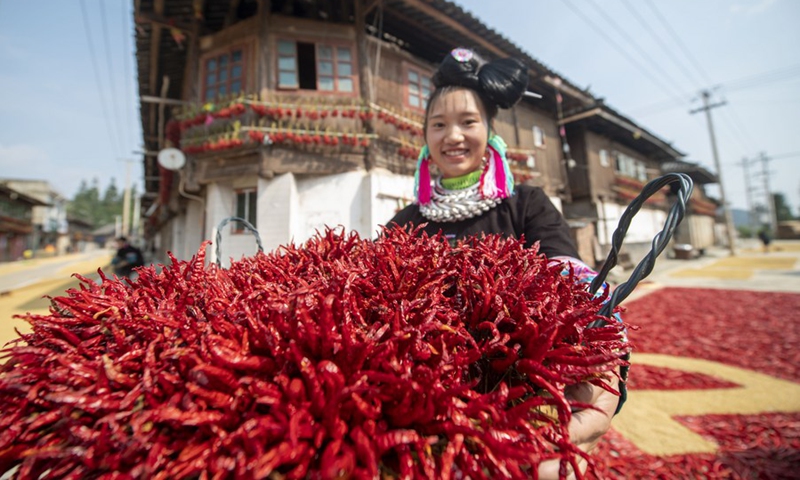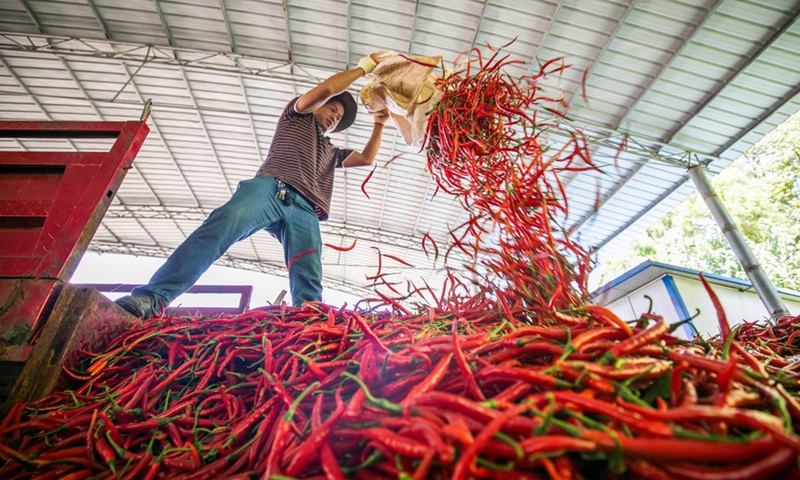
A villager shows harvested chili peppers in Donglang Township of Congjiang County, southwest China's Guizhou Province, Sept. 12, 2021.(Photo: Xinhua)

A villager sorts out harvested chili peppers in Zhaile Township of Nayong County of Bijie City, southwest China's Guizhou Province, Sept. 11, 2021.(Photo: Xinhua)
In the fall harvest season, the scent of chilies fills a small town in southwest China's Guizhou Province.
The town of Xiazi in the city of Zunyi is a famous chili transaction center. Farmers from hundreds of miles away take their chilies there to sell, and brokers with different accents travel there to buy the red produce, which later features on dining tables across the country and around the world.
"We have seen another bumper harvest year," said Zhang Zhongyi, an official in charge of the chili industry in Guizhou. He said he expects the average income of chili farmers to reach more than 4,000 yuan (about 625 U.S. dollars) per mu this year, or 60,000 yuan per hectare.
Guizhou is one of the largest chili production and sales bases in China. An exotic plant species like the tomato, chilies are called "haijiao" by many locals, which literally means "sea chili."
"The word has revealed that the species came from the sea," Zhang said, noting that it was through the ancient Maritime Silk Road that chilies were imported to China from South America.
Hundreds of years ago, the inland region of Guizhou was short of salt, so locals turned to chilies to add flavor to their dishes. Chilies have now become a symbol of the province, with the related products exported to 108 countries and regions.
Xiazi Town resident Chen Shunguo began engaging in the chili business 28 years ago at the age of 18.
"Carrying a basket on my back, I bought chilies from farmers in the fields before selling them in the market. At that time, a non-local broker could buy up to 1,500 kg in the market and have them delivered by train," said Chen, now 46.
Today, Chen's company covers an area of more than 700 square meters, which includes a processing zone, a transaction zone and a warehouse, in a chili trading center of the town. His company handles some 2,000 tonnes of chilies every year.
As a national chili market, the trading center "China Chili City" is home to about 300 chili businesses like Chen's. The center has integrated transactions, processing and packaging, cold chain warehousing, logistics distribution, financial services and other functions.
In Suotang Village of Meitan County, some 20 km away from Xiazi Town, 42-year-old farmer Li Wei prepares for the next round of fertilization.
Li used to grow a few plants for his own kitchen. Since growing 3.3 hectares of chilies in 2018, he has found chili plantation to be a lucrative business. This year, he decided to expand the business by contracting a total of 33.3 hectares from his fellow villagers with a cooperative.
He hired locals to apply mulch film and plant, weed and harvest the chilies, paying them more than 100 yuan a day. The chili pickers he employs are mostly middle-aged and elderly women who barely had incomes in the past.
"The cooperative not only makes better use of villagers' farmlands, but also brings them extra income," Li said, adding that he spent 200,000 yuan this year on workers' wages.
The province has bred 183 new species of chilies and introduced more than 120 chili varieties. In 2021, Guizhou planted 380,000 hectares of chilies, with an expected yield of 7.8 million tonnes worth over 27 billion yuan.
